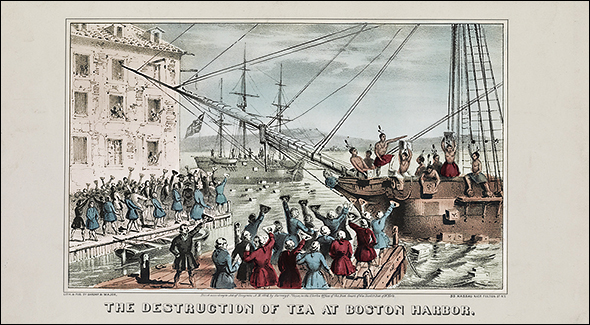Off the beaten track at NARA
It was, the history books tell us, 246 years ago today.
The date: 16 December 1773.
The place: Griffin’s Wharf, Boston, Massachusetts.
The event: Angry over English imposition of “taxation without representation,” American colonists — disguised in Native American clothing — dumped 342 chests of tea, imported by the British East India Company, into Boston Harbor.1

The Legal Genealogist knows it simply as The Boston Tea Party.
And recently came across images and mentions of it in the records of the U.S. National Archives.
In a record group I had never heard of before.
Something called Record Group 148, or the Records of Exposition, Anniversary, and Memorial Commissions.
Now… let’s back up a minute.
We all know — or we should — that the National Archives and Records Administration, called NARA for short, is the official archive of the United States: “the nation’s record keeper. Of all documents and materials created in the course of business conducted by the United States Federal government, only 1%-3% are so important for legal or historical reasons that they are kept by (NARA) forever.”2
And those documents and materials kept by NARA are organized into what are called Record Groups — RGs for short — numbered groups “comprising the records of a major government entity, usually a bureau or an independent agency.”3
So, for example, all of the records of the U.S. Mint are in Record Group (RG) 104, Records of the U.S. Mint, with just a few exceptions (some correspondence and personnel records are in RG 56, General Records of the Department of the Treasury). And all of the records of the U.S. Coast Guard and its predecessor agencies are in RG 26, Records of the United States Coast Guard.
So… what in the world goes into Record Group 148, the Records of Exposition, Anniversary, and Memorial Commissions?
It turns out there are at least 14 different commemorative-type commissions — including the one where the Boston Tea Party plays a role — whose records are collected in RG 148:
• George Washington Bicentennial Commission 1928-32
• George Rogers Clark Sesquicentennial Commission 1928-40
• Northwest Territory Celebration Commission 1935-39
• Goethals Memorial Commission 1935-55
• U.S. Constitution Sesquicentennial Commission 1937-40
• U.S. New York World’s Fair Commission 1937-41
• U.S. Golden Gate International Exposition Commission 1937-41
• Thomas Jefferson Bicentennial Commission 1940-44
• National Capital Sesquicentennial Commission 1947-52
• Alexander Hamilton Bicentennial Commission 1954-58
• Lincoln Sesquicentennial Commission 1957-60
• Golden Spike Centennial Celebration Commission 1967-70
• President’s Commission for the Observance of Human Rights Year 1968 1968-69
• Kaho`olawe Island Conveyance Commission 1993
It’s that first one, the George Washington Bicentennial Commission, where you’ll find the Boston Tea Party connection. It has “correspondence, working papers, and other records created or collected by the commission; correspondence and comments on the validity and interpretation of the data relating to the life of George Washington; research material relating to the history of Washington, DC, and environs; and Commission and miscellaneous publications relating to Washington, 1928-32.”4 And clearly the Boston Tea Party was part of setting the stage for Washington’s role in history.
These aren’t the only commissions like this: there’s a whole bunch of ’em in RG 79 — Records of the National Park Service, of Anniversary Commissions upon which the NPS Director Served as Executive Officer 1935-73. They include the United States Commission for the Celebration of the Two Hundredth Anniversary of the Birth of John Marshall, the Jamestown-Williamsburg-Yorktown Celebration Commission, the Battle of New Orleans Sesquicentennial Celebration Commission, the Jefferson Memorial Commission, the Civil War Centennial Commission, the National Parks Centennial Commission, and the Woodrow Wilson Centennial Celebration Commission.5
So… why should we as genealogists care? After all, these commissions aren’t collecting original records from the Boston Tea Party…
Well… Maybe we had a relative who was involved in one of these commissions. They tended to have a lot of members and get a lot of people to work with them. Maybe one of the commemorative events took place in the town where our people lived — and there were a lot of photos taken and collected from those events.
And maybe just being able to look at some of the estimated 3,377,975 textual pages in this record group, or the maps and charts, or the photographs, will help us advance our research goals or illustrate our research results. The images in the George Washington Bicentennial Commission group, for example, include everything from a profile of Mrs. John Jay (Sarah Van Brugh Livingston) to a profile of a Chief of the Little Osages.
And, of course, a copy of the 1846 Sarony & Major lithograph of the destruction of tea at Boston Harbor.6
There are all kinds of goodies to be found at the National Archives.
Even in the most unusual of record groups.
Cite/link to this post: Judy G. Russell, “An unusual record group,” The Legal Genealogist (https://www.legalgenealogist.com/blog : posted 16 Dec 2019).
SOURCES
- See generally “Boston Tea Party,” History.com (https://www.history.com/ : accessed 16 Dec 2019). ↩
- See “About : What is the National Archives and Records Administration?,” National Archives (https://www.archives.gov/ : accessed 16 Dec 2019). ↩
- Ibid., “Record Group Explorer.” ↩
- Ibid., “Records of Exposition, Anniversary, and Memorial Commissions,” Guide to Federal Records in the National Archives of the United States. ↩
- Ibid., “Records of the National Park Service,” Guide to Federal Records in the National Archives of the United States. ↩
- Okay, so I cheated, and got a color copy from the Library of Congress. ↩


